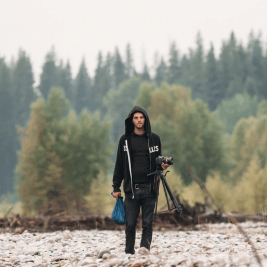Planning your first ski vacation? Searching for a few useful skiing tips? You’ve reached the right place. Skiing can’t be learned overnight. It takes patience and practice. And even expert skiers are still brushing up their skills from time to time. And if you’ve been off the slopes for quite some time, you might need to relearn a couple of skiing skills and techniques.
So whether you’re a beginner or have come back from a long hiatus, these skiing tips will help you avoid accidents and make the most out of your ski adventures.
You’ll also know what to expect once you are skiing the slopes. So being prepared and having at least the basic knowledge will help you make only beautiful memories and no injuries.
Skiing Tips For Beginners 101: Your First Ski Vacation
Skiing is fun, but it does come with risks. These tips will help beginners enjoy every single minute they spend on the slopes.
1. Obtain lessons from the professionals
Even if you have expert skiers in the family, it’s still best to obtain knowledge from a professional who is licensed to teach skiing skills. An expert ski adviser will help you maximize your potential. He will also be able to correct your form and give you tips on the proper technique.
These professionals were trained. And they also have a keen eye. So they can watch your every move and they can foresee future problems.
While your friend or a family member may be a great skier, he may not have these qualities. Being an expert skier is one thing. But being an effective ski adviser is another, and they took extensive training to be effective teachers too.
2. Wear the appropriate outfit and have the right gear
Before embarking on your first skiing lesson, make sure to dress the part.
Denim and jeans are a no-no, and even winter clothes that are not deemed fit for skiing should not be worn.
Though you do not necessarily have to look like a pro or an athlete, you have to wear the proper attire.
Consider investing in proper ski wear and gear, from the boots, snow pants, to the jacket.
Wear snow boots and not just regular boots. The proper fitting snow boots will help keep your feet comfortable so you can maximize the entire day. I would highly recommend checking out this site outdoorfilming.com for excellent ski boots.
Snow pants will help keep you dry, comfortable, and toasty enough.
You can also invest in ski gloves and goggles. This gear will help you maximize your time on the slope and not in the lodge. It’s important also to wear a properly fitting ski so that you will be comfortable enough to move.
3. Ski at the right resort
Not all ski resorts have terrains that are built for beginners. Some of the more famous ski resorts might have more terrains that are made for intermediate and expert skiers.
So what you’re looking for is a ski resort with ample terrains for beginners. They must also have programs for families and have several ski schools. So whenever you need to brush up on your skills, you’ll not have to look elsewhere.
Also ensure that the ski resort has excellent grooming, which is more accessible for beginners and those we need to polish their skills more. For more about skiing near NYC – check out our ski guide.
4. Don’t be ashamed to stay on the green lane
Most of your friends may be hitting the blue lane for intermediate skiers already. Don’t be tempted to join them unless you have already perfected your skills as a beginner.
Always start on the right type of terrain. Terrains for beginners have fewer obstacles, are less steep, and are smoother.
So in case you fall, you will incur serious injuries. So don’t be ashamed to stay on the green lane until you have conquered all your challenges as a beginner. This will also make you more skilled and hey, everyone needs to start somewhere. For more about all the types of ski lane colors and their difficulty levels read this article.
5. Take your time
Patience is a virtue and it still is in skiing. Never rush to head to the intermediate or blue lane in a day.
Don’t be too hard on yourself, It’s not a contest.
Also, do set realistic expectations. And just focus on what you know and how to deal with your challenges, nothing else.
No one’s going to give you a medal for getting to the blue lane faster than anybody else.
6. Don’t forget to bend your knees
While intermediate and expert skiers are used to assuming a squatting position while skiing, beginners might find it awkward.
Also, a lot of beginners tend to straighten their legs. And this can make you lose your balance and agility.
Bending the knees keeps you more agile and helps maintain the balance of your body. So this keeps you better in control.
Always ensure that your heels are in the cup of the boot. This will help you maintain a squatting position.
7. Always look forward
Wearing long planks under your feet for the first time might feel awkward. That’s why beginners tend to look and stare at where the tips go when they’re skiing.
And when you always look down on your feet, you are likely to bump into someone or something. So the key to keeping looking forward is to be aware of your surroundings.
8. Stay Balanced
Keep your hips square under your torso, and your shoulders should always be pointing downward.
Wearing the planks for the first time can be challenging, especially when you feel that your boots are pushing you forward. So beginners either lean way too forward or lean all the way back.
Skiing in balance will be easier. Though having your feet in front of your body will not make you fall right there and then, it can be tiring for your leg muscles.
9. Embrace falling
This is probably one of the most important of all skiing tips. Provided that you’re in the right lane and going slow, don’t be afraid to fall. You will make a lot of falls as a beginner, that’s inevitable.

But you must also learn how to fall properly. Practice falling on your sides instead of falling forward or backward. This will prevent you from twisting your ankle.
You can also wear pads to minimize the bruises.
10. Practice getting off a chair lift
Learning who to get off a chair lift is essential. It’s a basic skill. You don’t want to be caught off guard once you’re going into another slope.
So you can practice by using a bench. Sit on a bench and practice unloading. Focus on getting off the bench as if you are getting up from a chair, always keep your weight even on both tips with one hand reaching forward and the other holding the tips. And oh, don’t forget to bend your knees.
Press your shins against the front of your ski boots and glide.
Now that you’re on the chairlift, don’t forget to keep your ski tips up. And if you have someone with you, plan ahead on the direction that each of you will unload. And don’t forget to look in the direction where you want to go.
Final Say
Learning is fun. But skiing is not an easy feat, it requires the proper skills and technique. And beginners can make learning more fun with the tips that we have mentioned above. These will also prevent any untoward accidents too. Hope these skiing tips will make your first ski vacation a blast!
Karen works for a big hedge fund, she’s awesome with numbers and loves what she does, but above all – she loves traveling. Whenever she’s on the road, she tries to get into the gritty tiny details of every location she explores.










 Sarah Knapp is a Brooklyn based entrepreneur whose love for the outdoors and community building led her to the October 2013 creation of OutdoorFest. She has a BA in History, is a Wilderness First Responder and a NY state hiking, camp and boating guide. Her proudest achievement to date is reading the Aeneid in Latin.
Sarah Knapp is a Brooklyn based entrepreneur whose love for the outdoors and community building led her to the October 2013 creation of OutdoorFest. She has a BA in History, is a Wilderness First Responder and a NY state hiking, camp and boating guide. Her proudest achievement to date is reading the Aeneid in Latin.  Allison was one of our first top writers and Chief Editor but is no longer working with offMetro. Allison is a native New Yorker, who has lived in Rome, Tuscany, Melbourne, Toronto and Los Angeles. She frequently contributed travel pieces to Family Travel Forum, using her own children as guinea pigs as they travel the globe. She never missed a chance to sample local delicacies, as her love for travel goes hand-in-hand with her love for food and wine.
Allison was one of our first top writers and Chief Editor but is no longer working with offMetro. Allison is a native New Yorker, who has lived in Rome, Tuscany, Melbourne, Toronto and Los Angeles. She frequently contributed travel pieces to Family Travel Forum, using her own children as guinea pigs as they travel the globe. She never missed a chance to sample local delicacies, as her love for travel goes hand-in-hand with her love for food and wine.  Josh Laskin is a freelance travel writer and photographer based in the White Mountains of New Hampshire. When he is not at work or on the road, you can find him in the mountains snowboarding, climbing, hiking, fly fishing, mountain biking, and eating bagel bites.
Josh Laskin is a freelance travel writer and photographer based in the White Mountains of New Hampshire. When he is not at work or on the road, you can find him in the mountains snowboarding, climbing, hiking, fly fishing, mountain biking, and eating bagel bites. Annie is a travel writer, environmentalist, and surfer based in Venice, CA. She heads up our West Coast team, keeps our grammatical errors in check, and makes sure our California writers always have a plan for their next adventure. Follow Annie’s travels @annelisemcb.
Annie is a travel writer, environmentalist, and surfer based in Venice, CA. She heads up our West Coast team, keeps our grammatical errors in check, and makes sure our California writers always have a plan for their next adventure. Follow Annie’s travels @annelisemcb. Carly Pifer is a freelance writer who has been known to follow whims inspired by romantic movie scenes or colorful street style shots to India, Japan, Tunisia and Argentina. After stints living in Seoul, Boston, Paris and Los Angeles, writing and searching for something intangible, she landed somewhat steadily in Brooklyn and has begun to find inspiration in her more immediate surroundings.
Carly Pifer is a freelance writer who has been known to follow whims inspired by romantic movie scenes or colorful street style shots to India, Japan, Tunisia and Argentina. After stints living in Seoul, Boston, Paris and Los Angeles, writing and searching for something intangible, she landed somewhat steadily in Brooklyn and has begun to find inspiration in her more immediate surroundings.  Kate E. O’Hara is a New York based freelance writer and photographer who loves all things food—especially the people who make it and market it. Her writing aims to capture the essence of the food experience; the stories that go well beyond a plate of ingredients. In addition to her love of food, Kate is also known to have a hankering for red wine and craft beer. You can also find Kate on Instagram
Kate E. O’Hara is a New York based freelance writer and photographer who loves all things food—especially the people who make it and market it. Her writing aims to capture the essence of the food experience; the stories that go well beyond a plate of ingredients. In addition to her love of food, Kate is also known to have a hankering for red wine and craft beer. You can also find Kate on Instagram